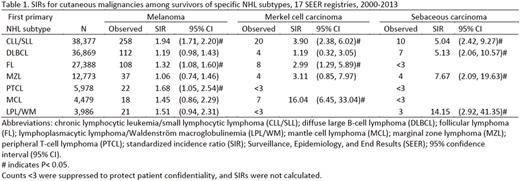Abstract
Introduction. Advances in treatment have improved prognosis after diagnosis with non-Hodgkin lymphoma (NHL) and chronic lymphocytic leukemia/small lymphocytic lymphoma (CLL/SLL). Understanding factors that impact long-term morbidity and mortality of lymphoma survivors is therefore of increasing clinical importance. Elevated risk for developing cutaneous melanoma after lymphoma is well-established, but the potential extension of this association for rarer NHL subtypes and other types of cutaneous malignancies is unknown.
Methods. We identified a cohort of 129,850 non-HIV infected adults (age ³20 years) who were initially diagnosed with one of the seven most common types of lymphoma (Table 1) during 2000-2013 and who survived ³1 year, as reported to 17 United States population-based cancer registries from the Surveillance, Epidemiology, and End Results program. Standardized incidence ratios (SIRs) and corresponding 95% confidence intervals (95% CI) quantified risks for second primary melanoma, Merkel cell carcinoma, and sebaceous carcinoma, comparing the observed number of cases to that expected in the general population based on age-, race-, sex- and calendar period-specific incidence rates.
Results. Melanoma occurred in 258 survivors of CLL/SLL, nearly two-fold more often than expected in the general population (SIR=1.94, 95% CI=1.71-2.20). Risk also was significantly elevated among survivors of follicular lymphoma (N=108, SIR=1.32, 95% CI=1.08-1.32) and peripheral T-cell lymphoma (N=22, SIR=1.68, 95% CI=1.05-2.54), whereas SIRs were non-significantly greater than unity after other NHL subtypes except marginal zone lymphoma (N=37, SIR=1.06, 95% CI=0.74-1.46). Merkel cell carcinoma and sebaceous carcinomas were much rarer but were associated with substantially higher risks compared with melanoma. Merkel cell carcinoma also occurred most commonly after CLL/SLL (N=20, SIR=3.90, 95%CI=2.38-6.02) with significantly elevated SIRs after follicular lymphoma (N=8, SIR=2.99, 95%CI=1.29-5.89) and mantle cell lymphoma (N=7, SIR=16.04, 95% CI=6.45-33.04). In contrast, the risk patterns differed for sebaceous carcinoma, with elevated risks after CLL/SLL (N=10, SIR=5.04, 95% CI=2.42-9.27), DLBCL (N=7, SIR=5.13, 95% CI=2.06-10.57), marginal zone lymphoma (N=4, SIR=7.67, 95% CI=2.09-19.63), and lymphoplasmacytic lymphoma/Waldenstršm macroglobulinemia (N=3, SIR=14.15, 95% CI=2.92-41.35).
Conclusions. Survivors of specific lymphoma subtypes have differential risks of developing a range of subsequent cutaneous malignancies. CLL/SLL is the lymphoma subtype most closely associated with cutaneous malignancy risk, whereas DLBCL survivors only have strongly elevated risk for sebaceous carcinoma. Further studies should investigate potential roles for immune dysfunction, infection, and genetic susceptibility in the etiology of cutaneous malignancies developing after NHL. Survivors and clinicians should consider the importance of regular full skin examinations to maximize opportunities for early detection of cutaneous malignancies to reduce morbidity.
No relevant conflicts of interest to declare.
Author notes
Asterisk with author names denotes non-ASH members.


This feature is available to Subscribers Only
Sign In or Create an Account Close Modal